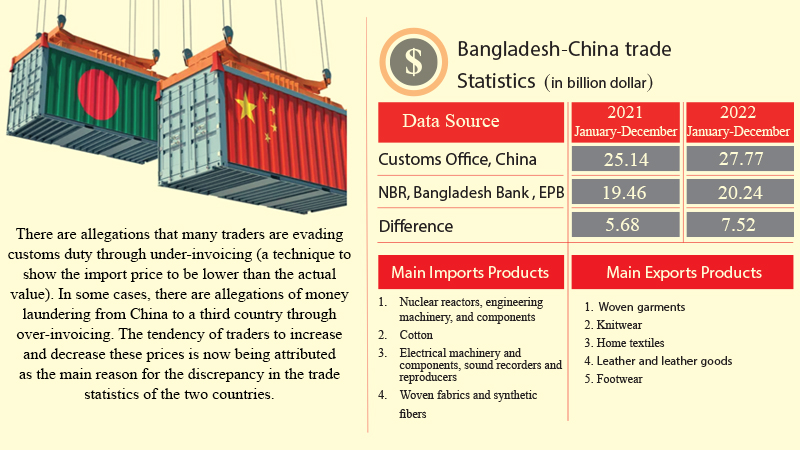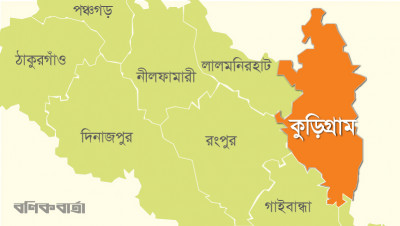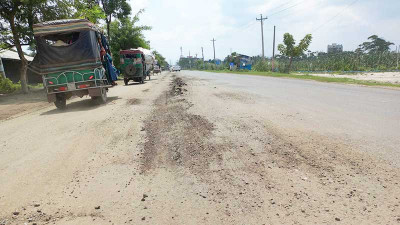
The big difference in Bangladesh's trade
statistics with China became a common scenario. China is Bangladesh's largest
partner in bilateral trade. But the trade gap in the official statistics of the
two countries is growing day by day. China's trade statistics are published by
the nation's Customs Office. In Bangladesh, this work is done by the National
Board of Revenue (NBR), Bangladesh Bank, and Export Promotion Bureau (EPB). The
analysis of the integrated data of the relevant authorities shows that the gap
between the official data of the two countries on the size of bilateral trade
in 2021 was 5.68 billion dollars. In last year's statistics, this gap increased
to 7.52 billion dollars. Accordingly, in the last two years, the amount of
discrepancy in the trade data of the two countries has exceeded 13 billion
dollars.
There are allegations that many traders
are evading customs duty through under-invoicing (a technique to show the
import price to be lower than the actual value). In some cases, there are
allegations of money laundering from China to a third country through
over-invoicing. The tendency of traders to increase and decrease these prices
is now being attributed as the main reason for the discrepancy in the trade
statistics of the two countries.
Even the policymakers are not able to rule
out the allegation of discrepancy in the data of the two countries due to
increasing and decreasing the prices of import and export products. In addition
to this, they believe that not considering the bond facilities and imports may
also be the reason for the informational gap.
Tapan Kanti Ghosh, Senior Secretary of the
Ministry of Commerce told Bonik Barta, "The possibility of increasing and
decreasing the prices cannot be ruled out. That could also be a reason for the
difference. However, from the discussions with the customs authorities we found,
the main reason for the difference in the figures between the two countries is
that many imports in Bangladesh come under the bond facility. The product is
then processed and returned. If it comes under the bond, it is not considered
an import.
Analysts and observers of the trade sector
say that a large part of importers is involved in under-invoicing to take
advantage of the import duty. Again, some traders are showing higher prices of
goods to take advantage of money laundering to third countries through China.
This trend is especially seen among importers of export-oriented industries
such as the garment sector. As it is relatively easy to negotiate with Chinese
exporters, this money is often being laundered through collusion with them.
There are allegations of money laundering in this way against many of the
country's big defaulting businessmen. There have also been complaints against
some of them for paying the import price using dollar hundi and showing low LC
prices from Bangladesh.
Bankers feel that it is necessary to look into the discrepancy in the trade statistics of the two countries now. Some sources related to the country's banking sector have confirmed the Bonik Barta that the total number of LCs opened for importing goods from China in the country is higher than the figure mentioned in the Customs Office figures.
বাংলাদেশ-চীন বাণিজ্য : দুই বছরে গরমিল ১৩ বিলিয়ন ডলার |
Analyzing NBR data the Bangladesh Bureau
of Statistics (BBS) says, the trade between Bangladesh and China in 2021
(January to December) was slightly more than 19.46 billion dollars. According
to Bangladesh Bank and EPB statistics, the value of trade between Bangladesh
and China in the year 2022 was 20.25 billion dollars. So the total trade value
of the two countries in the last two years stands at 39.75 billion dollars.
Meanwhile, the General Administration of
Customs China (GACC) statistics show that the value of trade between the two
countries in the year 2021 was slightly more than 25.14 billion dollars. In 2022, the size of trade was 27.77 billion
dollars. In total, the volume of trade between the two countries was 52.92 billion
dollars. So the gap between the trade data of the two countries in two years stands
at 13.16 billion dollars.
Bangladeshis involved in bilateral trade
is claiming that this huge difference in trade statistics has been reported in
various discussions held with NBR and Bangladesh Bank. They complain that such
informational differences are not good for Bangladesh, and no effort has been
made yet to find out the reason or publish the correct statistics to eliminate
the differences.
When asked about this, the spokesperson of
Bangladesh Bank Md. Mezbaul Haque said to Bonik Barta, "Why there is a difference
between the official data of the two countries can be identified by verifying
the basis of the statistics of the two. Without due analysis, it would not be
appropriate to comment on whether there is any unfair practice."
Some businessmen conducting trade with
China, told Bonik Barta on the condition of anonymity, "Bangladesh exports
to China are scanty. In order to take advantage of the import duty, many people
are showing low prices while importing products from China. Small and medium
businessmen are most at risk. Due to the difference in information, they need
help in determining the cost of the product. Again, a large amount of goods is
being imported from China in loose containers. Questions have also been raised
about their quality in many times.
Chinese exporters are taking rebates on
export prices at the time of shipping goods to Bangladesh. Bilateral trade
stakeholders say that the duty rate in Bangladesh should be determined based on
the rebate value. There is a need to move away from the practice of charging on
the value mentioned in the letter of credit. In this way, under-invoicing
opportunities are created due to different tariff rates depending on the price.
In Bangladesh, from NBR to Bangladesh Bank, all concerned are monitoring based
on statistics. As a result, there is no justification for such a huge
difference in the trade statistics between the two countries.
Chittagong Chamber of Commerce and
Industry President Mahbubul Alam told Bonik Barta, 'There may be differences in
the official statistics of the two countries. But there is no justification for
it being such a huge amount.
Bangladesh China Chamber of Commerce and
Industry (BCCCI) President Gazi Golam Murtoza is saying the same thing to Bonik
Barta, "If there is any difference in the statistics published by the two
government authorities, then it must be removed. If necessary, the
representatives of the respective government authorities of the two countries
can sit together and work on reducing this difference.
A large amount of machinery and parts come
to Bangladesh from China. The representatives of the government said that the
issue of increasing and decreasing the prices of these products is involved.
According to them, the import duty is on minimum import value. In this
opportunity, the price can be shown lower and the duty can be reduced. In this
case, there is collusion between the Chinese exporters and Bangladeshi
importers. China's allies want exports to show as much as possible. Because the
more exports there are, the more discounts they get.
The Commerce Ministry's statement on this
is that it is the responsibility of NBR and Bangladesh Bank to look into the
issues. In this case, the gap between the calculated value and the LC value is
a reason for statistical differences. The false declaration also plays a big
role in this difference. That is also being done with the aim of tax evasion.
Basically, the trend of reducing the price has been created from duty evasion.
And inflated prices are usually shown for money laundering. There are two types
of practices among businessmen in Bangladesh and China.
Within the country, there are differences
in the data collection methods of the concerned agencies. For this reason,
analysts believe that different information appears in the statistics of each
organization on the same subject. Their advice in this regard is that the
amount of money sent abroad against the import of goods in the country and the
amount of money against the goods received in the country in the case of
exports, the actual accounting of these two should be done in a due process and
with transparency. Bangladesh's participation in world trade is gradually
increasing now. She is currently in the process of becoming a developing
country. Meanwhile, a large information gap in commercial transaction data will
question the credibility of Bangladesh's data to organizations in other
countries. Foreign investors will also get a negative message from this. If
other countries in the world can properly store these data, then there is no
reason why Bangladesh cannot.
Bangladesh customs authorities said, there
are two issues here. First of all, it should be enquired which value statistics
are being published in both countries. A source of information may be the LC or
the value mentioned in the letter of credit. Another is the assessed value. If
the estimated figures are published, there may be differences. But if the
statistics are published according to the LC value in both countries, then
there is no chance of difference.
Former Commissioner of Chittagong Customs
and Director General of Customs Intelligence and Investigation Directorate Mohammad
Fakhrul Alam told Bonik Barta, "I know that there is a discrepancy in the
information. But Bangladesh Bank can provide correct information about this
matter. Because Bangladesh Bank settles all import-export LCs.
China is the largest trading partner of
Bangladesh. According to government statistics, about 14% of the total trade,
including imports and exports, is with China. Bangladesh's imports from the
country include nuclear reactors, engineering machinery and components, cotton,
electrical machinery and components, sound recorders and reproducers, woven
fabrics, synthetic fibers, etc. Exports from Bangladesh to China include woven
garments, knitwear, home textiles, leather and leather goods, footwear, etc. About
25% of the country's total imports come from China. But only a meager 1.31% of
the country's total export destination is China.
Translated by Sabidin Ibrahim






